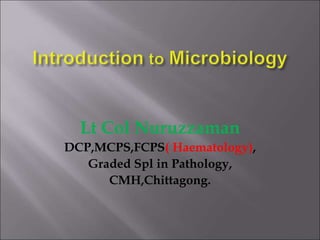
Introduction to microbiology.ppt
- 1. Lt Col Nuruzzaman DCP,MCPS,FCPS( Haematology), Graded Spl in Pathology, CMH,Chittagong.
- 2. MICROBIOLOGY: Science dealing with detailed study of microorganisms MICROORGANISM: Small living organism beyond the vision of naked eye
- 3. ORIGIN OF EARTH: 4.6 X 109 years ORIGIN OF LIFE: 1.5 X 109 years HISTORY
- 4. 1590 – First compound light microscope Zacharias Janssen
- 5. 1676 –first observation of bacteria “animalcules” Anton Von Leeuwenhoek (a Dutch draper )
- 6. 1796 – First vaccine (smallpox) Edward Jenner
- 7. 1857 – Germ Theory of Disease Louis Pasteur (French chemist)
- 8. 1867 Antiseptic Surgery Joseph Lister (British army surgeon):" Father of antiseptic surgery”,
- 9. 1884 ‘Koch’s Postulates of Disease Transmission’ Robert Koch (German army physician, Father of modern microbiology),
- 10. The organisms should be consistently associated with diseases & should be found in the lesions observed Microorganisms should be grown in pure culture in vitro When such pure culture is inoculated, typical disease must result Microorganisms must again be isolated from the lesions of such experimental animals Exceptions: v Treponemma pallidum & M. leprae can’t be grown in artificial media v Gonococcus has no animal models
- 11. 1885 - Vaccine against Rabies Louis Pasteur
- 12. Genetic engineering Cloning Human Genome Project Biotechnology Who knows what is next?
- 13. B D C A : Non-living matters B : Plants C : Animals D : Microbes A
- 14. BACTERIA: Unicellular microorganism having prokaryotic type of cellular organization VIRUS: Extremely small, obligate intracellular infectious agents containing either DNA or RNA as their genome FUNGUS: Unicellular or multicellular, nonphotosynthetic eukaryote having rigid cell wall. PROTOZOA: Unicellular, nonphotosynthetic, microbial eukaryote belonging to parasite. SLIME MOULDS: Microbial eukaryotes, which at one stage of their life cycle contain an amoeboid mass of cytoplasm called Plasmodium.
- 15. Virus - 10 →1000 nanometers * Bacteria - 0.1 → 5 micrometers ** (Human eye ) can see .1 mm (1 x 10 -3 m) * One billionth or 1 x 10 -9 m ** One millionth or 1 x 10 -6 m
- 16. Compound light Microscope - live specimens - 1,000 mag. or less Electron Microscope - non-living specimens - > 1,000 X mag. Incubator – keep microbes warm for growth
- 17. Staining – to better see structures Microbial Culture - growing the wee beasties Container for microbe culture - usually Petri dish Culture media - Food for the microbes - E.g. Agar – (from red algae) - Others such as nutrient broths
- 18. 1. Primary microscopy from the specimen/sample 2. Inoculation of suitable medium/media with the sample. *MEDIUM : Artificial food for the growth of bacteria. It may be solid (to study the morphology of colony), semisolid (To detect motility) or liquid (To yield faster growth) 3. Analysis of the colonial morphology of the responsible pathogen 4. Biochemical and immunological tests to identify the organism 5. Drug sensitivity test
- 19. Linaenian system : (Binominal classification) Genus & Species Hierarchical system : Phyla, Class, Order, Family, Genus, Species etc
- 20. MICROORGANISM Prokaryotes Eukaryotes Sub cellular 1. Bacteria 1. Algae 1. Virus (Incl Chlamyda, mycoplasma & Rickettsia) 2. Archaebacteria 2. Fungi 2. Viroids 3. Cyanobacteria 3. Slime moulds 3. Prions 4. Protozoa 4. Virinos
- 21. 1. According to morphology : Cocci or dot-shaped Bacilli or rod-shaped Vibrios or comma-shaped e.g V.cholerae Spirillar or twisted e.g Spirochaetes (T. pallidum) Cocco-bacilli e.g Brucella, Bordetella
- 24. Gram +ve cocci Gram –ve cocci Gram + ve bacilli Gram –ve bacilli
- 25. 2. According to Gram,s Staining : Not stainable : Spirochaetes, Chlamyda, Rickettsia etc Stainable: Gram positive bacteria Gram negative bacteria
- 26. 3. According to both morphology & Gram’s staining: a. Gram positive cocci Staphylococcus Streptococcus Pneumococcus (S. pneumoniae) Enterococcus (Grows in MacConkeys agar) Micrococcus (Strict aerobe) Peptostreptococcus (Strict anaerobe)
- 27. b. Gram positive bacilli Corynaebacterium (C. diphtheriae) Lactobacillus (Dental carries) Bacillus Clostridia (Strict anaerobe) Listeria (L. monocytogenes-Neonatal meningitis) Erysepelothrix Eubacterium (Strict anaerobe) Bifidobacterium (Strict anaerobe) Propionibacterium (Strict anaerobe
- 28. C. Gram negative cocci Neisseria ( N. gonorrhoeae, N. meningitidis) Branhamella Moraxella Veillonella Acinetobacter
- 29. D. Gram negative bacilli Escherichia coli* Salmonella Shigella Klebsiella* Enterobacter* Proteus Pseudomonas Citrobacter Serretia Edwardsiella *Rapid lactose fermenters
- 30. 4. According to the requirement of O2 and CO2: Aerobes & facultative anaerobes( Grow both in presence & in absence of O2) Strict aerobes (Grow only in presence of O2) Strict anaerobe (Grow only in absence of O2) Microaerophilic : (5-10 % O2) Capnophilic : (5-10 % CO2)
- 31. 6. Numerical classification 7. Molecular classification: Based on : DNA content DNA homology Ribotyping
- 32. Points Prokaryotes Eukaryotes Nucleus • Nuclear membrane • Chromosome • Nucleoli • Cell division Absent Single chromosome Absent Binary fission Present Multiple chromosome Present Mitosis Cell wall peptidoglycan Present (Except mycoplasma) Absent Cell membrane containing Sterol No (Except mycoplasma) Yes Cytoplasm Membrane-bound organelles (Mitochondria, Golgi body, ER etc) o Ribosomes o Protoplasmic streaming Absent 70 s Absent Present 80 s Present